- IdiomaAfrikaans Argentina AzÉrbaycanca
á¥áá áá£áá Äesky Ãslenska
áá¶áá¶ááááá à¤à¥à¤à¤à¤£à¥ বাà¦à¦²à¦¾
தமிழ௠à²à²¨à³à²¨à²¡ ภาษาà¹à¸à¸¢
ä¸æ (ç¹é«) ä¸æ (é¦æ¸¯) Bahasa Indonesia
Brasil Brezhoneg CatalÃ
ç®ä½ä¸æ Dansk Deutsch
Dhivehi English English
English Español Esperanto
Estonian Finnish Français
Français Gaeilge Galego
Hrvatski Italiano Îλληνικά
íêµì´ LatvieÅ¡u Lëtzebuergesch
Lietuviu Magyar Malay
Nederlands Norwegian nynorsk Norwegian
Polski Português RomânÄ
Slovenšcina Slovensky Srpski
Svenska Türkçe Tiếng Viá»t
Ù¾Ø§Ø±Ø³Û æ¥æ¬èª ÐÑлгаÑÑки
ÐакедонÑки Ðонгол Ð ÑÑÑкий
СÑпÑки УкÑаÑнÑÑка ×¢×ר×ת
اÙعربÙØ© اÙعربÙØ©
Inici / Àlbums / Denver RTD 65
Visualitza:
Llista mensual
Data de publicació / 2016

 ADAPT (131)
ADAPT (131)
Denver Post Thursday October 11, 1984 Photo by Damian Strohmeyer/Denver Post: In a wide open plaza with almost no one in it, a lone person sits in a motorized wheelchair, back to the camera. In the distance at the other side of the plaza is a city bus, and behind it a group of people stand in a cluster. On the back of the wheelchair there are several bumper stickers, including "Disabled but able to vote", "Bill Armstrong", something with diagonal stripes that is unreadable, and "Build ramps not steps" with a picture of person in a wheelchair doing a wheelie. Caption reads: Lee Jensen at the scene of the ribbon cutting that opened new RTD Broadway station. Eight disabled Denverites protested the opening. Official contends transit funds scarce by Judith Brimberg If metropolitan Denver wants federal help for something like light rail, it must come up with a combined highway-transit plan for improving transportation in the region, the head of the federal Urban Mass Transportation Administration said Wednesday. Even then, administrator Ralph Stanley acknowledged, officials would be better off to rely on local money and public/private partnerships to finance light rail or some other system of mass transit. In Denver for the opening of the turnaround facility at the Civic center shuttle station, Stanley said in the interview that the days of big federal money for such projects are past. Because of tight federal budgets, cities must rely on the income from the 1982 gasoline tax increase for new projects. The 1 cent dedicated to public transit amounts to 1.2 billion a year, only 400 million is for new transit projects nationwide. Noting that cities asking for $36 billion worth of projects are ahead of Denver, RTD board chairman Bryon Johnson said in a separate interview, “it’s clear we will have to do it with our own money. Waiting for federal money is like queuing up in a store that is running out of merchandise.” Stanley said if gasoline tax were raised again, more money would be available for new projects. But noting that the 5 cent a gallon tax barely got through Congress two years ago, he said he thought waiting for another increase in the near future would be a waste of time. There still is federal money available for construction projects, and Stanley announced Wednesday that RTD will get more than $6 million to plan and construct a new central shops facility. Buses now are repaired and painted in shops at the Alameda and Platte garages. RTD General Manager Ed Colby said the new centralized facility would have more sophisticated repair equipment. ADAPT (132)
ADAPT (132)
Rocky Mountain News Tuesday, Jan. 11, 1983, Denver, Colo. New RTD board Oks lifts for 90 buses By Burt Hubbard News Staff The news Regional Transportation District board, to the applause and cheers of wheelchair-bound onlookers, voted Monday night to spend $1.3 million to equip almost 90 new buses with lifts for the handicapped. The decision, by a 13-1 voted, reversed a yearlong policy against the lifts by the old board. It was the newly seated board’s first official decision and was made despite a recommendation by the agency executive director L.A. Kimball not to buy the equipment. “It’s not a question of money,” said RTD board member Byron Johnson. “It’s a question of federal, state and local government recognizing that the handicapped person has been ignored.” About 30 disabled people at the meeting cheered and applauded the decision after the roll was called. Only RTD board member Ann Walton voted against the lifts. The 15th member, Mary Duty, was in the hospital. Kimball who opposed buying the lifts, said the decision would mean delivery of the buses will be delayed up to four months. The buses had been scheduled to begin arriving in August. The lifts will cost $1.3 million with federal funds paying 80 percent. In other action, Kimball reported that through 1983, the district has spent more than $9.3 million studying light rail and acquiring land for rights-of-way. In addition, six staff members will spend all year working on light-rail activities, he said. The old RTD board has proposed a 77-mile system that would cost at least $5.8 billion by the time it would be finished in 2002. But several members of the new board have said they want to consider alternatives to light rail. Boxed Text: New RTD board elects chief Retired banker William Johnson on Monday night narrowly was elected chairman of the new Regional Transportation District board after more than two hours of voting and 10 ballots. Johnson, board member from Jefferson County, won by an 8-6 vote over former state Rep. Jack McCroskey, board member from Central Denver. The decision came after three other candidates dropped out of the balloting. Other candidates who withdrew during the balloting were Bill Rourke, Don Feland and Ann Walton.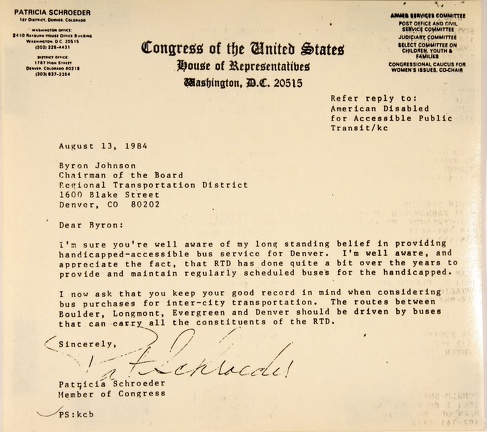 ADAPT (133)
ADAPT (133)
PATRICIA SCHROEDER 1st District, Denver Colorado Washington Office: 3410 Rayburn House Office Building Washington DC 20515 (202)229-4431 District office: 1787 High Street Denver, Colorado 80218 (303) 837-2354 ARMED SERVICES COMMITTEE POST OFFICE AND CIVIL SERVICE COMMITTEE JUDICIARY COMMITTEE SELECT COMMITTEE ON CHILDREN, YOUTH & FAMILIES CONGRESSIONAL CAUCUS FOR WOMEN'S ISSUES. CO-CHAIR Refer reply to: American Disabled for Accessible Public Transit/kc August 13, 1984 Byron Johnson Chairman of the Board Regional Transportation District 1600 Blake Street Denver, CO 80202 Dear Byron: I’m sure you’re well aware of my long standing belief in providing handicapped-accessible bus service for Denver. I’m well aware, and appreciate the fact, that RTD has done quite a bit over the years to provide and maintain regularly scheduled buses for the handicapped. I now ask that you keep your good record in mind when considering bus purchases for inter-city transportation. The routes between Boulder, Longmont, Evergreen and Denver should be driven by buses that can carry all the constituents of RTD. Sincerely, Patricia Schroeder Member of Congress PS : kcb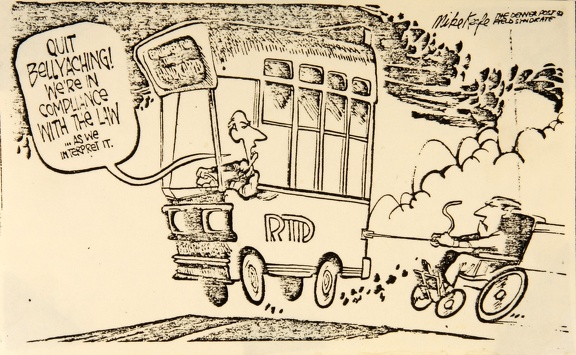 ADAPT (134)
ADAPT (134)
Cartoon by Denver Post Field Syndicate Mike Keefe of a city bus, RTD written on the side, with a guy in a wheelchair holding on to a rope tied to the back of the bus. The guy in the wheelchair has a sour expression on his face. The bus driver is looking out the window and yelling back at the guy being pulled "QUIT BELLYACHING! We’re In Compliance with the law . . . As We Interpret It."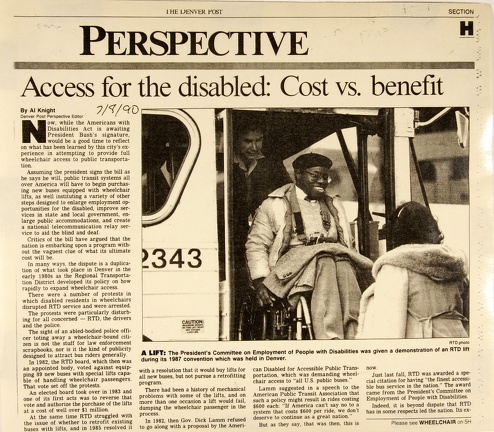 ADAPT (135)
ADAPT (135)
The Denver Post 7/8/90 [This article continues in ADAPT 138, but the entire story has been included here for easier reading] Perspective Access for the disabled: Cost vs. benefit Photo by RTD staff: A smiling African American man in a manual wheelchair, wearing a beret and with a sports coat over his lap is being helped to board a city bus by the driver, who is behind him. In front of the lift a woman stands waiting to board. Caption reads: A LIFT: The President's Committee on Employment of People with Disabilities was given a demonstration of an RTD lift during its 1987 convention which was held in Denver. By Al Knight Denver Post Perspective Editor Now, while the Americans with Disabilities Act is awaiting President Bush’s signature, would be a good time to reflect on what has been learned by this city's experience in attempting to provide full wheelchair access to public transportation. Assuming the president signs the bill as he says he will, public transit systems all over America will have to begin purchasing new buses equipped with wheelchair lifts, as well instituting a variety of other steps designed to enlarge employment opportunities for the disabled, improve services in state and local government, enlarge public accommodations, and create a national telecommunication relay service to aid the blind and deaf. Critics of the bill have argued that the nation is embarking upon a program without the vaguest clue of what its ultimate cost will be. In many ways, the dispute is a duplication of what took place in Denver in the early 1980s as the Regional Transportation District developed its policy on how rapidly to expand wheelchair access. There were a number of protests in which disabled residents in wheelchairs disrupted RTD service and were arrested. The protests were particularly disturbing for all concerned — RTD, the drivers and the police. The sight of an abled-bodied police officer toting away a wheelchair-bound citizen is not the stuff for law enforcement scrapbooks, nor is it the kind of publicity designed to attract bus riders generally. In 1982, the RTD board, which then was an appointed body, voted against equipping 89 new buses with special lifts capable of handling wheelchair passengers. That vote set off the protests. An elected board took over in 1983 and one of its first acts was to reverse that vote and authorize the purchase of the lifts at a cost of well over $1 million. At the same time RTD struggled with the issue of whether to retrofit existing buses with lifts, and in 1985 resolved it with a resolution that it would buy lifts for all new buses, but not pursue a retrofitting program. There had been a history of mechanical problems with some of the lifts, and on more than one occasion a lift would fail, dumping the wheelchair passenger in the process. In 1982, then Gov. Dick Lamm refused to go along with a proposal by the American Disabled for Accessible Public Transportation, which was demanding wheelchair access to “all U.S. public buses." Lamm suggested in a speech to the American Public Transit Association that such a policy might result in rides costing $600 each: “If America can't say no to a system that costs $600 per ride, we don't deserve to continue as a great nation.“ But as they say, that was then, this is now. Just last fall, RTD was awarded a special citation for having "the finest accessible bus service in the nation." The award came from the President's Committee on Employment of People with Disabilities. Indeed. it is beyond dispute that RTD has in some respects led the nation. Its experience in developing its current fleet of buses was the prime example used by congressional supporters of the Americans with Disabilities Act. In addition, it is a fact that RTD was the first agency to order its over-the-road buses equipped with lifts. Until RTD's first order, these larger vehicles had been built without lifts. The RTD program hasn’t been accomplished without significant expense. It has cost about $8 million for the lift equipment and millions more for parts, maintenance and training. But the latest figures show per-ride costs are far below the $600 figure mentioned by Lamm. The lifts cost about $13,000 a copy. Because the life of a bus normally is calculated at 12 years, this works out to a little more than $1,000 a bus per year. To this must be added the maintenance cost, which has been dropping each year. As recently as 1985 the cost of maintaining an individual lift was $1,798. This year the average is just over $500. Even without the retrofitting program rejected by the board in 1985, RTD has managed to increase greatly its percentage of lift-equipped buses. In 1985, only 54 percent of buses were so equipped. This year 81 percent are. In recent years, disabled ridership has gone up sharply. In 1982 it was just over 9,000 wheelchair boardings, but last year it reached an estimated 45,000. According to RTD figures, the per-ride cost may have reached $80 in 1984, but with the increase in ridership and the drop in maintenance cost, the cost per ride now has dropped to about $19 a ride, according to the latest calculations. What is not known is how many of Denver’s disabled community actually are served by the lifts. In the mid-1980s, it was estimated that only a few hundred wheelchair-bound residents were regular bus riders. Even as RTD has fitted new buses with the lifts, demands for its HandyRide service have continued to increase. This door-to-door service is available to both the elderly and the handicapped. Some of its wheelchair passengers could be served by regular buses, but many others are unable to get to the bus stop and therefore require the HandyRide service. Precise calculations aren’t available, but it is estimated the cost per ride for using the van service is about $50. Lamm, contacted this week, said he basically hasn’t changed his position on the issue. He said the $600 figure he used in 1982 was based on the experience of the St. Louis bus company. “To govern is to choose," he said, "and I don't believe this nation should make every bus wheelchair-accessible. Should the handicapped be provided transportation? Of course, but it should be provided in the most cost-effective way possible.” Lamm mentioned the expensive elevator system that is a part of the Washington, D.C., subway system as an example of a method that isn't cost-effective. The Denver experience does indicate that the costs of accommodating the wheelchair-bound citizen may not be an endlessly upward spiral. But the key indicator that needs watching is the number of passengers using the service. The taxpayers, the RTD board and staff members clearly have done their part. The wheelchair service is now available on nearly every bus, yet ridership has flattened out. The estimate of 45,000 wheelchair passengers for 1989 is just a few hundred higher than the 1986 level. More persons must be encouraged to use the service. Now that maintenance costs are down, the only way to decrease the still-considerate per-ride cost is to increase the number of passengers using the lifts. The most compelling case the disabled community can make for greater access is to demonstrate an even higher usage of the existing facilities. Highlighted Text: Even without the retrofitting program rejected by the board in 1985, RTD has managed to increase greatly its percentage of lift-equipped buses. In 1985, only 54 percent of buses were so equipped. This year 81 percent are. Photo by The Denver Post/Duane Howell: A slight woman in a wheelchair is being escorted out by two uniformed and one plainclothes police. She is telling one of the officers something and they are all listening with slight smiles on their faces. Behind this group a man in a wheelchair is following, escorted by another police officer and behind them three other policemen stand guard. Caption reads: PROTEST: An unidentified demonstrator at the Regional Transportation District office was escorted out during a 1982 protest over the purchase of new buses.![ADAPT (136) (2391 visites) HCC [Handicapped Coloradan?] 2/84
Two photos by Bob Conrad: Top photo of person in a sports jac... ADAPT (136)](_data/i/upload/2016/06/01/20160601181511-3591b3ff-sm.jpg) ADAPT (136)
ADAPT (136)
HCC [Handicapped Coloradan?] 2/84 Two photos by Bob Conrad: Top photo of person in a sports jacket and in a manual wheelchair on a lift getting ready to enter a bus with "Ride" written on the side. He is facing in toward the door of the vehicle. Bottom photo is of a person in a wheelchair sitting on a lift facing out the door of a bus. A man [Wade Blank] with long blonde hair and a plaid jacket stands beside the lift watching. Wheeler for a Day Jay Bear Baker, an RTD district director, finds out first hand what it's like to travel via "The Ride" when you're in a wheelchair. Baker was accompanied on the mid-February excursion by members of the American Disabled for Accessible Public Transportation (ADAPT). Baker boarded buses at Broadway and Colfax and traveled along Lincoln and Alameda. Four out of the five buses he attempted to ride had functioning lifts. in the bottom photo ADAPT member Wade Blank watches as Baker is lowered to the curb. Baker's rides included a trip on one of the 89 new articulated buses. Those are the buses which were equipped with lifts only after the newly elected RTD board voted to reverse a decision made by the old appointed board and former RTD General Manager L.A. Kimball. "The lift worked beautifully, " Blank said. "I've heard that a lot of drivers are praising it, too. " The expedition with Baker is part of a plan by ADAPT to encourage RTD to continue to make its system totally accessible to wheelchair riders. Blank said he's encouraged by some of RTD's 177 more lift-equipped buses as well as to correct wiring problems in many of like current lifts. RTD has also approved the use of a lift equipped over-the road coach on the Denver-Boulder run on an experimental basis. Blank said he has met with new RTD General Manager William Colby and warned him that Colorado’s three favorite sports were "skiing, hiking, and criticizing RTD."![ADAPT (137) (1641 visites) PHOTO: Two uniformed police officers carry a man in a manual wheelchair [Glen Kopp?] down a flight ... ADAPT (137)](_data/i/upload/2016/06/01/20160601181520-ac5d1035-sm.jpg) ADAPT (137)
ADAPT (137)
PHOTO: Two uniformed police officers carry a man in a manual wheelchair [Glen Kopp?] down a flight of stairs. The man has a slightly annoyed look on his face. An ADAPT person is standing between the others and the camera, watching the police carry the other man.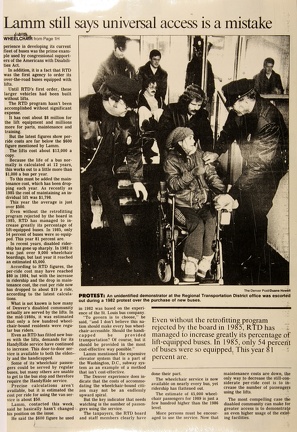 ADAPT (138)
ADAPT (138)
This article is a continuation of the story in ADAPT 135 and the text is included there in its entirety for easier reading. ADAPT (139)
ADAPT (139)
PHOTO: A group of about 20 people in wheelchairs and a couple of folks not in wheelchairs sit in a circle facing mostly toward the center. In the middle of the room, at the center of the people is an unattended L-shaped desk with a typewriter and other materials on it. Two people in wheelchairs sit at either end. Others are mostly up against the walls forming an informal circle. The group appears to be occupying a lobby-reception area.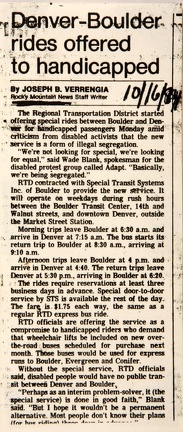 ADAPT (140)
ADAPT (140)
Rocky Mountain News 10/16/84 Denver- Boulder rides offered to handicapped By JOSEPH B. VERRENGIA Rocky Mountain News Staff Writer The Regional Transportation District started offering special rides between Boulder and Denver for handicapped passengers Monday amid criticism from disabled activist that the new service is a form of illegal segregation. “We’re not looking for special, we’re looking for equal,” said Wade Blank, spokesman for the disabled protect group called Adapt. “Basically, we’re being segregated.” RTD contracted with Special Transit Systems Inc. of Boulder to provide the new service. It will operate on weekdays during rush hours between the Boulder Transit Center, 14th and Walnut streets, and down town Denver, outside the Market Street Station. Morning Trips leave Boulder at 6:30 a.m. and arrive in Denver at 7:15 a.m. The bus starts its return trip to Boulder at 8:30 a.m., arriving at 9:10 a.m. Afternoon trips leave Boulder at 4 p.m. and arrive in Denver at 4:40. The return trips leave Denver at 5:30 p.m., arriving in Boulder at 6:20. The rides require reservations at least three business days in advance. Special door-to-door service by STS is available the rest of the day. The fare is $1.75 each way, the same as a regular RTD express bus ride. RTD officials are offering the service as a compromise to handicapped riders who demand that wheelchair lifts be included on new over-the-road buses scheduled for purchase next month. Those buses would be used for express runs to Boulder, Evergreen and Conifer. Without the special service, RTD officials said, disabled people would have no public transit between Denver and Boulder. “Perhaps as an interim problem-solver, it (the special service) is done in good faith,” Blank said. “But I hope it wouldn’t be a permanent alternative. Most people don’t know their plans (for bus riding) three days in advance."![ADAPT (141) (3056 visites) Denver Post 2/16/85
PHOTO by Denver Post's Jim Pre[name cut off]: A uniformed policeman kn... ADAPT (141)](_data/i/upload/2016/05/10/20160510141018-7663317b-sm.jpg) ADAPT (141)
ADAPT (141)
Denver Post 2/16/85 PHOTO by Denver Post's Jim Pre[name cut off]: A uniformed policeman kneels beside a man in a wheelchair [George Roberts]. George has shades and an Afro and he is tilting his head to the side toward the policeman. The policeman is writing a ticket on his knee and George is telling him his information. Behind the two of them is another uniformed officer, visor on his cap shading his eyes, arms crossed across his chest and disapproving turn to his mouth. Behind him is a blurry crowd of people with their backs toward the camera. Caption reads: Officer R.H. Kaspersen issues a ticket to George Roberts during blockade of metro buses. Handicapped block buses 2 protesters are arrested; talks planned By Judith Brimberg 2/16/85 Denver Post Staff Writer For the second day in a row, wheelchair-bound protesters blocked an RTD bus in downtown Denver Friday. They were demonstrating against possible discontinuation of accessible bus service for the handicapped. Despite efforts by the Peña administration to mediate the dispute, the protest went off as scheduled, and two handicapped demonstrators were arrested. Denver police identified them as George Roberts, 36, and Renate Rabe, 30, who live in the same apartment complex at 1255 Galapago St. The pair, afflicted with cerebral palsy, were charged with impeding traffic and disobeying a lawful order. Rabe was released on her own recognizance, but Roberts, who participated in a similar demonstration several years ago, was held overnight in Denver County Jail. Thursday, another member of the disabled-rights group known as ADAPT, Mike Auberger, 30, was arrested at East Colfax Avenue and Cherry Street for impeding traffic. But efforts by Dale Saddler of the Mayor’s Commission on the Disabled ultimately paid off. Late Friday, both sides agreed to meet early next week to try to resolve the dispute. Demonstrations scheduled for this weekend were called off. The handicapped community contended that RTD failed to understand that separate, private transportation for the handicapped doesn’t meet everyone’s needs, said Wade Blank, an able-bodied demonstrator who organized the protests. On Tuesday, an RTD committee is to review policies affecting the elderly and the handicapped. Among the options to be considered are discontinuing accessible service on public buses and expanding handyride services or brokering services to private providers. In an interview, Blank said he organized the protests because “the handicapped aren’t going to be the stepping stones to a new budget.” More than two years ago, he and others obtained a commitment from RTD to install wheelchair lifts on 50 percent of the peak-hour buses. But RTD, like other transportation districts across the country, is facing severe cuts in federal aid and Blank fears the agency may try to balance its budget at the expense of the handicapped. Many wheelchair lifts have proved unreliable and costly to repair. Larry Perry, chairman pro tem of the RTD board, said Friday that Blank’s fears were groundless. “If they will sit down and talk with us, they will learn they won’t be hurt,” he declared. Earlier this week, however, General Manager Ed Colby told board members it costs $72 a year to maintain bus lifts because 12,000 disabled persons ride the buses each year. It’s cheaper to maintain lifts on the handy vans, Colby said. Blank countered that RTD is sabotaging its accessible program by refusing to perform inventive maintenance on the Colby’s handyride figures are distorted, he added, because they include the elderly as well as the disabled.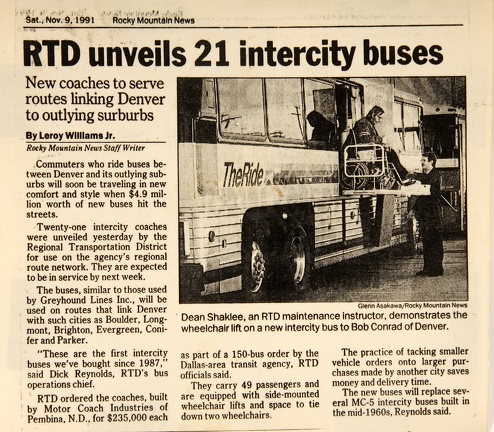 ADAPT (142)
ADAPT (142)
Rocky Mountain News Sat., 11/9/91 PHOTO by Glenn Asakawa, Rocky Mountain News: A man in a wheelchair [Bob Conrad] sits on a lift in the raised position. A man in a dark suit stands beside the lift. The lift comes out of the center of the driver's side of the large over-the-road-bus. The bus fills most of the frame, and you can see another behind it. TheRide is printed on the side. Caption reads: Dean Shaklee, an RTD maintenance instructor, demonstrates the wheelchair lift on a new intercity bus to Bob Conrad of Denver. RTD unveils 21 intercity buses New coaches to serve routes linking Denver to outlying suburbs By Leroy Williams Jr., Rocky Mountain News Staff Writer Commuters who ride buses between Denver and its outlying suburbs will soon be traveling in new comfort and style when $4.9 million worth of new buses hit the streets. Twenty-one intercity coaches were unveiled yesterday by the Regional Transportation District for use on the agency’s regional route network. They are expected to be in service by next week. The buses, similar to those used by Greyhound Lines Inc., will be used on routes that link Denver with such cities as Boulder, Longmont, Brighton, Evergreen, Conifer and Parker. “These are the first intercity buses we’ve bought since 1987,” said Dick Reynolds, RTD’s bus operation chief. RTD ordered the coaches, built by Motor Coach Industries of Pembina, N.D., for $235,000 each as part of a 150-bus order by the Dallas-area transit agency, RTD officials said. They carry 49 passengers and are equipped with side-mounted wheelchair lifts and space to tie down two wheelchairs. The practice of tacking smaller vehicle orders onto larger purchases made by another city saves money and delivery time. The new buses will replace several MC-5 intercity buses built in the mid-1960s, Reynolds said.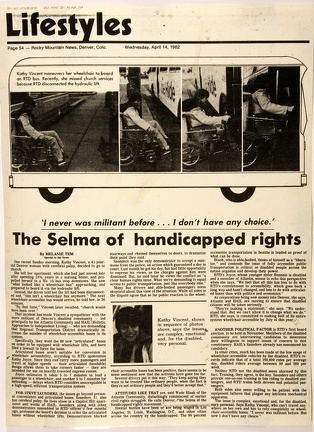 ADAPT (77)
ADAPT (77)
The Selma of handicapped rights By Melanie Tem One recent Sunday morning, Kathy Vincent, a 41-year-old Denver woman with cerebral palsy, decided to go to church. She left her apartment, which she had just moved into after spending years in a nursing home, and propelled herself to a No.15 bus stop downtown. She saw "what looked like a wheelchair bus" approaching, and prepared to board it via the hydraulic lift. Instead, the driver told her the lift had been disconnected and, "this isn't a wheelchair bus anymore." The next wheelchair-accessible bus would arrive, he told her, in 30 minutes. "By that time," Vincent later recalled, "church would have been over." That incident has made Vincent a sympathizer with the more militant of Denver's disabled community - led principally by the Atlantis Community and HAIL(Holistic Approaches to Independent Living) - who are demanding that Regional Transportation District dramatically increase the number of wheelchair-accessible buses in its system. Specifically, they want the 89 new "articulated" buses on order to be equipped with wheelchair lifts, and have filed a lawsuit to force the issue. Articulated buses aren't suitable for conversion to wheelchair accessibility, according to RTD spokesman Kathy Joyce. Since they can carry more passengers and travel at higher speeds - their articulated (bendable) design allows them to take corners faster - they are intended for use on heavily traveled express routes. Joyce estimates it takes 5 to 7 minutes to load a passenger in a wheelchair, and another 5 to 7 minutes for unloading - delays which RTD considers unacceptable in a high-speed, efficient transportation system. FOR STEVE SAUNDERS, the issues go beyond personal convenience and articulated buses. Saunders, 31, also has cerebral palsy. He lives alone in a Capitol Hill apartment and works at HAIL. Saunders, along with other demonstrators assembled in RTD offices a few months ago, protested the board's decision to order the articulated buses without wheelchair lifts. Demonstrators blocked stairways and chained themselves to doors, to dramatize their point they said. Saunders was the only demonstrator to accept a summons from the police, an action which guaranteed a day in court. Last month he got his day, but had little opportunity to express his views, as the charges against him were dismissed. But, he said later he views the conflict as “a clear human rights issue. What we're demanding is equal access to public transportation, just like everybody else." Many bus drivers and able-bodied passengers seem skeptical about this view of the situation. While all sides in the dispute agree that so far public reaction to the wheelchair-accessible buses has been positive, there seems to be some sentiment now that the activists have gone too far. Several drivers put it this way: "They keep saying they want to be treated like ordinary people, when the fact is they're not ordinary people and they'd better accept that." Attitudes like that are, said Wade Blank of the Atlantis Community, disturbingly reminiscent of earlier civil rights struggles. He calls Denver, "the Seima of the handicapped rights movement." Similar battles have been or are being waged in Los Angeles, St. Louis, Washington, D.C., and other cities across the country by the handicapped. The 90 percent accessible transportation in Seattle is lauded as proof of what can be done. Blank, who is able-bodied, thinks of himself as a "liberator," and contends the issue of full accessible public transportation is critical as disabled people across the nation organize and develop their power. RTD's Joyce, whose younger sister Heannie is disabled and a member of Atlantis, seems to echo this perspective when she says, "We feel that all this has less to do with RTD’s commitment to accessibility, which goes back a long way and hasn't changed, and less to do with articulated buses than with politics and economics." As corporations bring new money into Denver, she says, Atlantis and HAIL are moving to ensure that disabled citizens will be taken seriously. "They're making a statement," she says. "We understand that. But we can't allow it to change what we do." RTD, she says, is committed to making half of its entire system wheelchair-accessible by July of this year. ANOTHER POLITICAL FACTOR is RTD's first board election, to be held in November. Members of the disabled community are interviewing candidates to determine their willingness to support issues of concern to that constituency. HAlL's Saunders already has announced his candidacy. In other cities, much has been made of the low usage of wheelchair-accessible vehicles by the disabled. RTD's records indicate that of a total 160,000 rides per average day, disabled riders average between 90 and 260 per week. Neither RTD nor the disabled seem alarmed by this fact. Training, they agree, is the key. Saunders and others provide one-on-one training in bus riding to disabled passengers, and RTD trains both drivers and potential passengers. Both sides also seem willing to be patient with the equipment failures that plague any intricate mechanical apparatus. The issue ls complex, emotional and, for the disabled, very personal. Says Kathy Vincent, who can't travel anywhere on her own and has to rely completely on wheelchair-accessible buses: “l never was militant before. But now l don’t have any choice."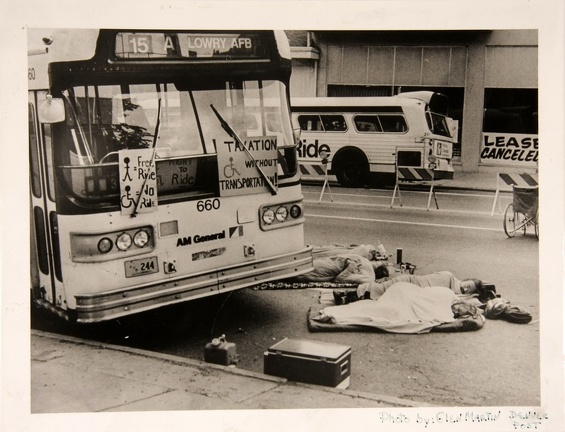 ADAPT (78)
ADAPT (78)
PHOTO by Gen Martin, Denver Post: Four men and women are lying wrapped in sleeping bags or blankets on pads in the street in front of a bus. The bus (15 A) once bound for Lowry AFB, now appears empty and on the front are 3 handmade posters. Two are outside under the windshield wipers. One says "Taxation without Transportation!" with a drawing of the access symbol; the other has a picture of a stick figure person next to an equals sign and the words Free Ride, and then an access symbol guy next to an equals sign and the words No Ride. Inside the window a third sign is partially visible with the access symbol and the words Right to Ride. There are police/traffic barriers down the middle of the street and a manual wheelchair. There is a bus parked on the opposite side of the street and behind it a city building with a big sign that says "lease canceled." Around the people lying down are small piles of stuff and there is a cooler by the curb.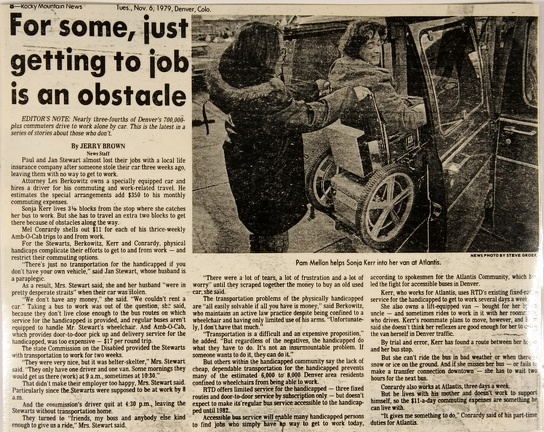 ADAPT (79)
ADAPT (79)
Rocky Mountain News Tues., Nov. 6, 1979, Denver, Colo Photo by Steve Groer, News: A woman in a parka stands, smiling, holding the push handles of another woman's wheelchair. The woman in the wheelchair is facing the camera and smiling, eyes closed, a polite face. She's about eye level to the woman standing behind her because she is on a lift getting into a van. Caption reads: Pam Mellon helps Sonja Kerr into her van at Atlantis. [Headline] For some, just getting to job is an obstacle EDITOR'S NOTE‘: Nearly three fourths of Denver's 700,000-plus commuters drive to work alone by car. This is the latest in a series of stories about those who don't. By JERRY BROWN News Staff Paul and Jan Stewart almost lost their jobs with a local life insurance company after someone stole their car three weeks ago, leaving them with no way to get to work. Attorney Les Berkowitz owns a specially equipped car and hires a driver for his commuting and work-related travel. He estimates the special arrangements add $350 to his monthly commuting expenses. Sonja Kerr lives 3 1/2 blocks from the stop where she catches her bus to work. But she has to travel an extra two blocks to get there because of obstacles along the way. Mel Conrardy shells out $11 for each of his thrice-weekly Amb-O-cab trips to and from work. For the Stewarts, Berkowitz, Kerr and Conrardy, physical handicaps complicate their efforts to get to and from work — and restrict their commuting options. There‘s just no transportation for the handicapped if you don't have your own vehicle,” said Jan Stewart, whose husband is a paraplegic. As a result, Mrs. Stewart said, she and her husband "were in pretty desperate straits" when their car was stolen. "We don't have any money," she said. “We couldn't rent a car." Taking a bus to work was out of the question, she said, because they don't live close enough to the bus routes on which service for the handicapped is provided, and regular buses aren't equipped to handle Mr. Stewart’s wheelchair. And Amb-0-Cab, which provides door-to-door pick up and delivery service for the handicapped, was too expensive - $17 per round trip. The state Commission on the Disabled provide the Stewarts with transportation to work for two weeks. “They were very nice, but it was helter-skelter," Mrs. Stewart said. “They only have one driver and one van. Some mornings they would get us there (work) at 9 a.m., sometimes at 10:30." That didn't make their employer too happy, Mrs. Stewart said. Particularly since the Stewarts were supposed to be at work by 8 a.m. And the commission's driver quit at 4:30 p.m., leaving the Stewarts without transportation home. They turned to “friends, my boss and anybody else kind enough to give us a ride," Mrs Stewart said. “There were a lot of tears, a lot of frustration and a lot of worry" until they scraped together the money to buy an old used car, she said. The transportation problems of the physically handicapped are "all easily solvable if all you have is money," said Berkowitz, who maintains an active law practice despite being confined to a wheelchair and having only limited use of his arms “Unfortunately, I don't have that much." “Transportation is a difficult and an expensive proposition," he added. “But regardless of the negatives, the handicapped do what they have to do. It's not an insurmountable problem. If someone wants to do it, they can do it." But others within the handicapped community say the lack of cheap, dependable transportation for the handicapped prevents many of the estimated 6,000 to 8,000 Denver area residents confined to wheelchairs from being able to work. RTD offers limited service for the handicapped — three fixed routes and door-to-door service by subscription only — but doesn't expect to make its regular bus service accessible to the handicapped until 1982. Accessible bus service will enable many handicapped persons to find jobs who simply have no way to get to work today, according to spokesmen for the Atlantis Community, which has led the fight for accessible buses in Denver. Kerr, who works for Atlantis, uses RTD’s existing fixed-route service for the handicapped to get to work several days a week. She also owns a lift-equipped van — bought for her by her uncle — and sometimes rides to work in it with her roommate who drives. Kerr’s roommate plans to move, however, and Kerr said she doesn't think her reflexes are good enough for her to drive the van herself in Denver traffic. By trial and error, Kerr has found a route between her home and her bus stop. But she can't ride the bus in bad weather or when there is snow or ice on the ground. And if she misses her bus -— or fails to make a transfer connection downtown -- she has to wait two hours for the next bus. Conrardy also works at Atlantis, three days a week. But he lives with his mother and doesn't work to support himself, so the $11-a-day commuting expenses are something he can live with. “lt gives me something to do, Conrardy said of his part-time duties for Atlantis.